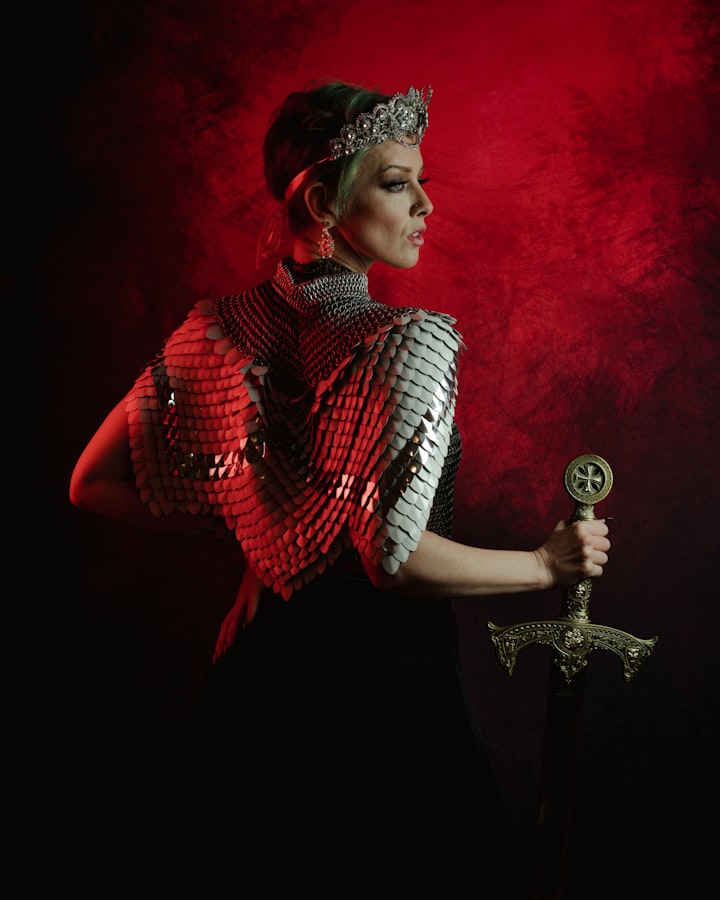Knights of the Free Will: The Holy Liberators
A homebrewed variant of the paladin class for 3.X D&D.

The tyrant of Gothonor, the self-styled King Hiram, was once a common thief and trader of slaves. Under the very noses of a corrupt and incompetent aristocracy he had raised an army of slaves and taken over the nation in a bloody coup. Now the kind and generous people of that nation were suspicious and secretive. Citizens were constantly in fear of being “vanished”, taken away by their new ruler’s secret force of assassins and buried in the wilderness where none would find them. Paranoia was the order of the day. Children regularly turned in their own parents for being “seditious” (committing such terrible crimes as complaining about having to wait in line to buy bread or saying things had been better under the murdered aristocrats). No one was happy in the tiny kingdom, but no one was brave enough to say so.
In the twenty-sixth year of the king’s reign, rebellion was in the air but nobody could tell where it was coming from. Messages started to appear on walls in plain sight of city guards with messages of liberation, freedom, and redemption. Endless investigations and purges followed, but the vandalism just continued and spread, gradually becoming more frequent. Few said so, but many throughout the kingdom began to believe the tyrant was losing control of the nation. Worse, as the graffiti spread, actual sabotage began to occur, roads leading from the capital being blocked by fallen trees, bridges mysteriously collapsing for no apparent reason, army arsenals suddenly catching fire in the dead of night, and never once were there any witnesses or clues left behind.
Finally, as groups of citizens became emboldened enough by the chaos to start resisting the tyranny on their own, the instigators of the rebellion revealed themselves. In every village and town in the little nation a band of knights appeared with trumpets blasting and flags waving and declared that the time for redemption had arrived. Disbelieving citizens quickly followed their lead, and the knights started leading bands of rebels in a vast march to the centre of the kingdom. Suddenly, seemingly from out of nowhere, a horde of angry farmers and shopkeepers and merchants surrounded the capital, marching with pitchforks and torches and scythes to lay siege to the city. Outnumbered by the enormous mobs, the thrall army of the king turned against him, seeing their own freedom at hand, and within a few short hours King Hiram was dragged out into the courtyard of his palace and hung from a great old tree. Over the next few weeks his assassins were rooted out and arrested or killed. The knights assigned councils to run elections for mayor of each tiny hamlet in the kingdom, and the mayors soon elected a parliament from among their numbers. The last heir of the original royal family was found and given ceremonial powers to help his people rebuild, and as liberty was restored the Knights of Freedom gathered before the palace then rode off into the night, unseen…
Liberators are knights dedicated to the protection of freedom and the end of tyranny. Anywhere the mighty oppress the weak or people are not free to live and believe as they wish, liberators will struggle to redeem the enslaved. Lovers of beauty and individuality, liberators seek to free the souls of all they meet, breaking the shackles that keep people enslaved, whether those bonds be iron or ingrained ideologies. They oppose institutions and cultural norms that enforce conformity and work to free people’s minds as well as their bodies, and are often thorn in the side of lawful religious orders.
GAME RULE INFORMATION
Liberators have the following game statistics.
Abilities: Charisma enhances a liberator’s ability to smite, self-protective abilities, and ability to channel energy. Strength is important for its important role in combat, something that all liberators must face without fear or hesitation. A Wisdom score of 14 or higher is required to get access to the most powerful liberator spells, and a score of 11 or higher is required to cast any divine spells at all.
Alignment: Passionate and freedom-loving, the Liberator must be Chaotic Good in alignment.
Hit Dice: 1d10
Advancement Table
Level Special Abilities
1 Aura of chaos, detect evil, smite evil 1/day
2 Divine grace, sunder bonds
3 Aura of resolve
4
5 Smite evil 2/day
6 Break enchantment 1/week, irrepressible
7 Special Mount
8
9 Break enchantment 2/week
10 Smite evil 3/day
11
12 Break enchantment 3/week
13
14
15 Smite evil 4/day, break enchantment 4/week
16
17
18 Break enchantment 5/week
19
20 Smite evil 5/day
Class Skills
The liberator’s class skills are bluff, climb, concentration, hide, intimidate, jump, knowledge (religion), ride, survival, diplomacy, profession, search, sense motive, craft, use rope, swim, move silently, tumble, balance.
Skill Points at 1st Level: (2 + Int. modifier) x 4.
Skill Points at Each Additional Level: 2 + Int. modifier.
Class Features
All of the following are class features of the liberator.
Weapon & Armour Proficiency: Liberators are proficient in simple and martial weapons, armour, and shields.
Detect Evil (Sp): At will, a liberator can detect evil as the spell.
Aura of Good: The power of a liberator’s aura of good (see the detect good spell) is equal to his class level.
Smite Evil (Su): Once per day, a liberator may attempt to smite evil with one normal melee attack. The liberator adds any Charisma bonus to the attack roll and deals 1 extra point of damage per class level. If the liberator accidentally smites a creature that is not evil, the smite attempt has no effect, but the ability is still used up for that day.
Divine Grace (Su): At 2nd level, a liberator gains a bonus equal to his or her Charisma bonus (if any) on all saving throws.
Sunder Bonds (Su): A liberator may attempt to sunder any chain, lock, or knot that binds a captive with one normal melee attack. The liberator adds any Charisma bonus to the attack roll and ignores 1 point of hardness per class level.
Aura of Resolve (Su): Beginning at 3rd level, the liberator gains immunity to all charm and compulsion effects. The liberator’s mind is free, and no other creature can control the liberator’s thoughts or actions. Each ally within 10 feet of the liberator gains a +4 morale bonus on saving throws against charm or compulsion effects. This ability functions while the liberator is conscious, not unconscious or dead.
Break Enchantment (Sp): Beginning at 6th level, a liberator can use break enchantment once per week. This ability may be used an additional time each week every additional 3 levels, to a maximum of 5 times a week at 20th level. Caster level is equal to the liberator’s class level.
Irrepressible: Starting at level 6, the liberator becomes a paragon of personal freedom, liberated from the ties that oppress both the mind and the body. The liberator can move through impediments as though under a permanent freedom of movement spell, and any form of non-magical chains, manacles, or other bondage placed on the liberator will slip off unless the knight wills them to stay on. Furthermore, the liberator adds his full Charisma score to his speed and his Charisma modifier, if any, to his initiative.
Special Mount (Sp): Upon reaching 7th level, a liberator gains the service of an unusually intelligent, strong, and loyal steed to serve her in her crusade against evil. This mount is usually a heavy warhorse (for a Medium liberator) or a war pony (for a Small liberator).
Once per day, as a full-round action, a liberator may magically call her mount from the celestial realms in which it resides. This ability is the equivalent of a spell of a level equal to one-third the liberator’s level. The mount immediately appears adjacent to the liberator and remains for 2 hours per liberator level; it may be dismissed at any time as a free action. The mount is the same creature each time it is summoned, though the liberator may release a particular mount from service.
Each time the mount is called, it appears in full health, regardless of any damage it may have taken previously. The mount also appears wearing or carrying any gear it had when it was last dismissed. Calling a mount is a conjuration (calling) effect.
Should the liberator’s mount die, it immediately disappears, leaving behind any equipment it was carrying. The liberator may not summon another mount for thirty days or until she gains a liberator level, whichever comes first, even if the mount is somehow returned from the dead. During this thirty-day period, the liberator takes a -1 penalty on attack and weapon damage rolls.
Code of Conduct: A liberator must be of chaotic good alignment and loses all class abilities if he or she ever willingly commits an evil act or enslave another sentient creature.
Additionally, a liberator’s code requires that members of the class attempt to free any slaves or captives they ever encounter, and to punish those who enslave or oppress others, and seek to overturn any unjust laws.
Associates: While a liberator may adventure with characters of good or neutral alignment, the knight will never knowingly associate with evil characters or any type of undead, nor will any association with someone who consistently offends the liberator’s moral code be continued. A liberator may not accept henchmen, followers, or cohorts who are evil.
Ex-Liberators
The holy liberator who ceases to be chaotic good or willingly commits an evil act, or grossly violates the code of conduct, loses all liberator spells and abilities (but not weapon or armour proficiencies). The warrior may not progress any farther in levels as a liberator. All class abilities and advancement potential may be regained if the violations are atoned for (see the atonement spell description), as appropriate.
Like any member of any other class, a liberator may be a multiclass character and has no special restrictions in this regard aside from alignment and the rules of the knight’s religious order.
About the Creator
Samuel Wright
I am a writer & tarot reader in Oregon. I'm a TTRPG fan, love all types of sci-fi & fantasy books, movies, & games, & read voraciously. I write a variety of content, mostly RPG blogs. Tell me where you found my page.
Art by Google/Unsplash






Comments
There are no comments for this story
Be the first to respond and start the conversation.